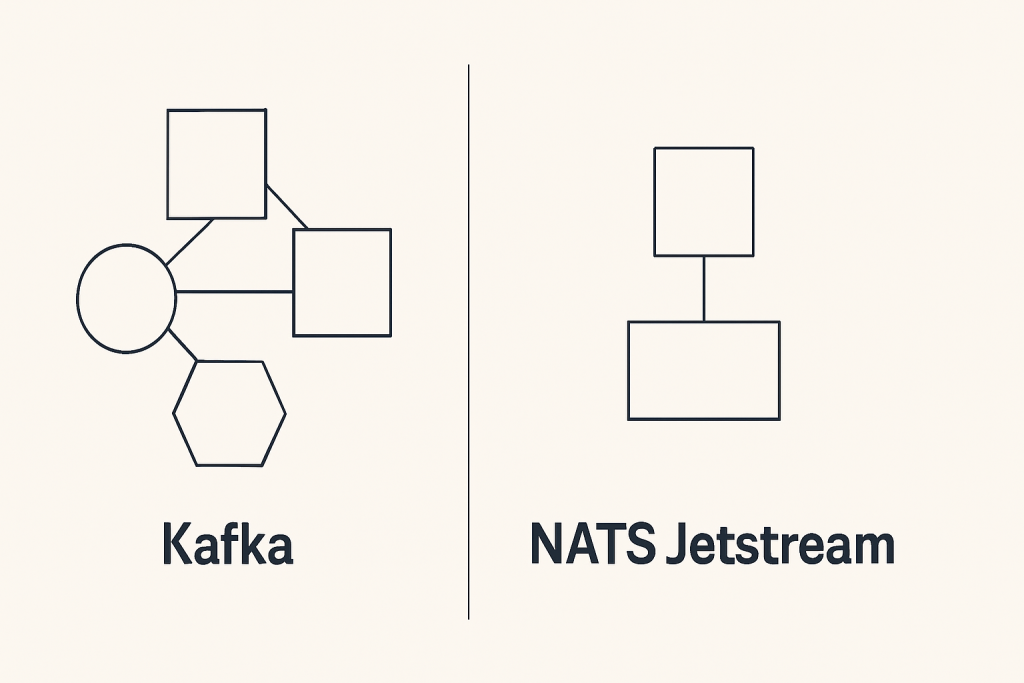Physical Address
304 North Cardinal St.
Dorchester Center, MA 02124
Physical Address
304 North Cardinal St.
Dorchester Center, MA 02124

Modern applications demand reliable, scalable, and performant messaging solutions. But as complexity grows, development and operational challenges escalate. NATS Jetstream offers a compelling solution by seamlessly blending simplicity with robust message persistence, making developers’ lives easier.
🎙️ Listen: Inside NATS Jetstream – Simplicity, Speed, and Why Developers Love It
NATS is a lightweight, high-performance open-source messaging system designed for speed and simplicity. Jetstream is NATS’s built-in persistence layer, extending NATS’s capabilities to provide durable message streams and guaranteed message delivery, while maintaining simplicity at its core.

Apache Kafka, a widely-used messaging system, relies on multiple distinct components. You need Kafka brokers to handle message storage and distribution, coordinated by services like ZooKeeper or the newer KRaft. This multi-component architecture means extensive setup, complex configuration, and significant operational overhead, especially as your system scales.
NATS Jetstream dramatically simplifies this. Its persistence features are integrated directly into the NATS server. Rather than managing multiple different services, you deploy a cluster of identical NATS servers. This integrated approach means fewer moving parts, faster deployments, simpler configurations, and reduced operational complexity.

Kafka uses a partitioned log-based storage model. Messages are stored in topics divided into partitions, requiring consumers to manually track their offsets. While powerful, this requires detailed client-side management, increasing complexity and potential for errors.
Jetstream simplifies this by storing messages in Streams. Consumers are defined and managed directly on the server-side. Jetstream provides various consumer types—Push, Pull, Durable, and Ephemeral—handling acknowledgments, message delivery guarantees (at-least-once, at-most-once), and filtering within the Jetstream layer itself. This significantly reduces the complexity developers face, allowing simpler and cleaner client-side implementations.
Kafka primarily supports a publish/subscribe paradigm, making other messaging patterns like request/reply or queueing more complex and often requiring additional custom code or third-party solutions.
NATS excels in providing native support for multiple messaging patterns. Beyond high-performance publish/subscribe, NATS inherently supports request/reply and queue groups. Jetstream builds on these capabilities by adding durability, enabling robust implementations of multiple messaging paradigms with minimal developer effort.
Managing Kafka requires significant resources, expertise, and ongoing operational attention. Tasks such as broker maintenance, coordination service monitoring, handling partition rebalances, version upgrades, and maintaining configuration consistency across multiple nodes are inherently complex.
NATS Jetstream, by contrast, significantly reduces operational overhead. The single integrated binary approach simplifies server management tasks such as upgrades and cluster expansion. Jetstream automates data placement, replication, and resilience, ensuring smooth operational experiences and drastically simplifying day-to-day management.
Getting started with NATS Jetstream is straightforward and quick, removing barriers to productivity:
With no external dependencies or complex configurations required, Jetstream ensures that your messaging infrastructure is operational rapidly, letting developers focus on building core application features.

Go’s lightweight, highly performant runtime underpins NATS Jetstream. Go excels at handling concurrency and resource efficiency, making Jetstream uniquely performant even under high workloads. The simplicity of Go also benefits developers directly by making integration, debugging, and extensions easier. Leveraging Go, NATS Jetstream achieves impressive throughput and low latency without complex tuning, ensuring high performance alongside ease of use.
Consider using Jetstream if:
NATS Jetstream stands out by marrying robust, high-performance messaging capabilities with unmatched simplicity and ease of use. For developers and teams seeking to minimize complexity and operational overhead, Jetstream provides a streamlined, powerful, and productive solution that just works.